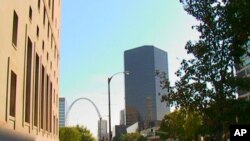The American City of St. Louis, Missouri — often called the Gateway to the West — is perhaps best known for a towering, architectural marvel. The city sits near the confluence of the Mississippi and Missouri Rivers, and played a major role in early America's Westward expansion.
Since the 18th century, St. Louis, Missouri has offered travelers a hub to begin their adventures into the western frontier. Its nickname — the "Gateway to the West" — is symbolized by the towering focal point of the St. Louis skyline: the Gateway Arch. It was all about location.
"St. Louis is pretty centrally located in the middle of North America. The arch, itself, is on the Mississippi River, and just about 18 miles (29km) north of here is the Missouri River, which runs all the way out to the Rocky Mountains," say historian Bob Moore. "So being on these river systems enabled St. Louis to be right in the middle of everything that was going on. People used the rivers as much as possible to get from place to place."
The city was already a natural stopping point for explorers coming from the Wild West and the bounty they were sending to the settled east, like beaver fur that was used for hats.
Meriwether Lewis and William Clark started their expedition here, when America's third President Thomas Jefferson — one of the founding fathers — sent them to explore land bought from France in the Louisiana Purchase of 1803.
But why did St. Louis develop on this particular piece of land?
"When the first settlers came there was a cliff face that was right next to the river. And, the only break in that bluff, was just about where the south leg of the arch is today. So, the leg of the arch you see behind me, that's where the break in the bluff was the easiest way to get from the river up to the top of the cliff. Because it's the first place along the river, closest to where the two rivers come together, where a community could be placed and could thrive and not have to worry about being flooded out."
Flooding may not have been an issue, but a great fire that started on the riverfront reduced much of old St. Louis to ash in 1849. While the American railroad system eventually lessened the importance of St. Louis as a trading capital, river transport still plays a role in regional commerce. And while Moore says the city never really bounced back from that economic downturn, it did still attract some modern industries, such as auto and airplane manufacturing. St. Louis is also home to an American favorite.
"Anheuser Busch is here, a manufacturer of beer going back to the 1800s," says Moore. "Budweiser since 1876, it all started here."
In addition to being the home of the world's largest-selling beer company, Moore says St. Louis offers many other amenities — especially free activities that can be helpful in tough times.
"Our zoo, our history museum, our art museum. Most of our cultural institutions are free of charge. It's wonderful for families because they can just take their kids and it isn't a huge, financial burden."
With many public places perfect for families, couples, kids and adults, Moore says there is still one place that visitors absolutely must experience.
"They have to come see the arch," he says.








